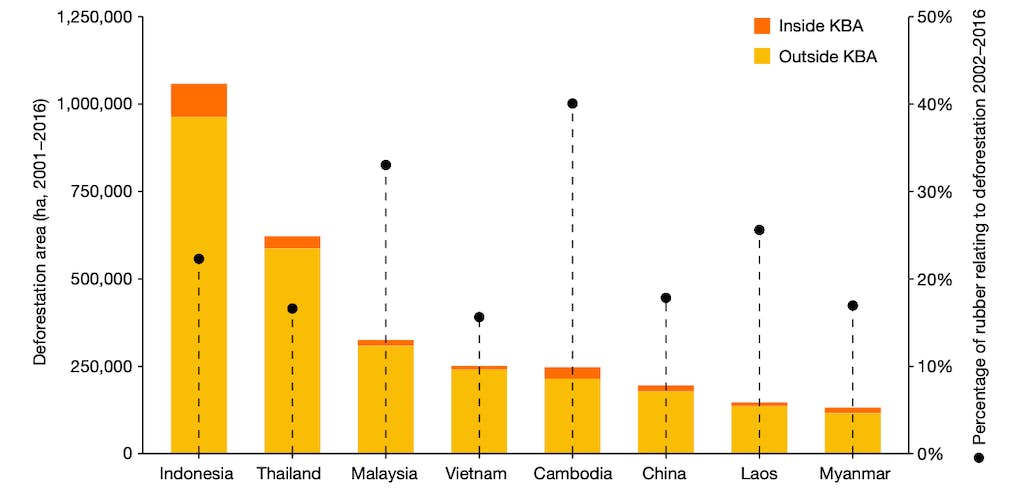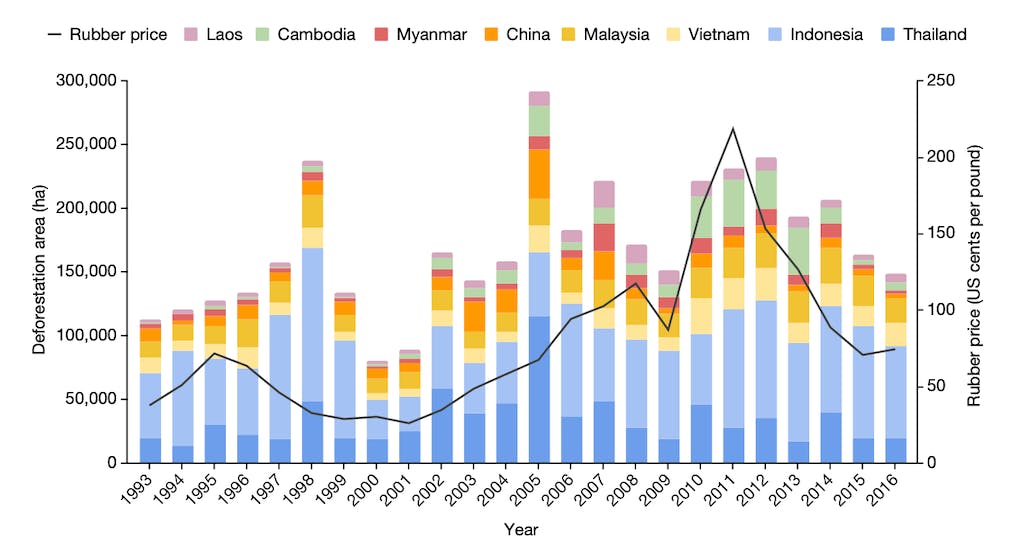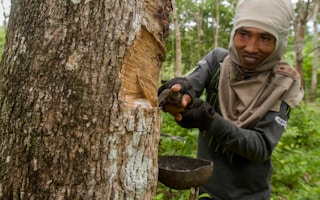The study, published in Nature, uses satellite data to produce high-resolution maps of rubber-driven forest loss in south-east Asia since 1993.
It finds that more than 4m hectares of tropical forests have been lost to rubber plantations in south-east Asia over the last three decades – at least two-to-three times more than previously thought. More than 1m ha of plantations have been established in key biodiversity areas.
The greatest forest losses occurred in Indonesia, Thailand and Malaysia, the research says. In Cambodia, more than 40 per cent of rubber plantations were associated with deforestation, of which 19 per cent was in key biodiversity areas.
The study has important implications for both domestic and global policy, one author tells Carbon Brief, with rubber causing “more deforestation than is assumed in data that underpinned policy in both the EU and the G7”.
However, they caution that rubber – a substantial and sustainable source of income for smallholder farmers with significant climate benefits – should not be “demonised” because of deforestation data.
Use, drivers and estimates
Used by the Indigenous peoples of Mesoamerica for generations before it was “discovered” by colonial regimes and introduced to other tropical regions, rubber is one of the most important crops that emerged from the rainforest.
Natural rubber is made by “tapping” a sticky sap called latex by making incisions in the bark of certain types of trees – predominantly the Hevea brasiliensis, a deciduous tree native to the Amazon basin that is now common across the tropics. The latex collected in cups is then processed to make it less brittle and treated with heat for durability.
Today, south-east Asia accounts for 90 per cent of the global rubber production, with the rest coming from South and central America and, more recently, west and central Africa. It is closely tied to tropical deforestation, which is largely driven by consumption in global markets.
Around 85 per cent of all natural rubber is produced by smallholder farmers on plantations that are often less than 5ha in size. This makes them hard to capture in satellite imagery and national crop statistics.
It is also difficult to distinguish rubber trees in satellite images because they appear quite similar to the forests they are grown adjacent to. Heavy cloud cover in rainforest regions further complicates the picture.
The study authors use high-resolution satellite imagery to map smallholder plantations, using composites across multiple years to tackle the challenges of cloud cover. They then zeroed in on a distinctive seasonal signature for rubber, based on when plantations shed and regain their leaves, to distinguish rubber plantations from evergreen and deciduous tropical forests.
According to the study, mature rubber plantations occupied an area of 14.2m ha in south-east Asia in 2021, with 70 per cent of the production located in Indonesia, Thailand and Vietnam.
Rubber-related deforestation was most widespread in Indonesia, followed by Thailand and Malaysia. The study also found that 40 per cent of all rubber plantations in Cambodia were associated with deforestation – the highest proportion of any country studied – with 19 per cent of this area located in areas of key biodiversity value.
The chart below shows the cumulative area of rubber-related deforestation in individual countries in south-east Asia over 2001-16. The orange bars represent the amount of deforestation that occurred in key biodiversity areas and the yellow bars show the amount of deforestation elsewhere. The circles represent the percentage of rubber production that was associated with deforestation within this period.

Area of rubber-related deforestation over 2001-16 for individual countries in south-east Asia. The figures for China include only its main production areas (Xishuangbanna and Hainan). Source: Wang et al. (2023)
The figures from this study for forest loss in Cambodia are “several hundredfold” higher than previous estimates relied on to inform EU, G7 and UK policy, according to the study.
Dr Antje Ahrends, head of genetics and conservation at the Royal Botanic Garden of Edinburgh and one of the authors of the research, warns that the study’s estimates – while significantly higher than most – are still understated. She tells Carbon Brief:
“You have to set a threshold on the imagery: if you set the threshold too low, then you are at risk of including all sorts of areas that are already heavily degraded, and if you set the threshold too high, then you miss lots of deforestation. So we actually opted for a very conservative threshold.”
Prof Erik Meijaard, an ecologist associated with the University of Kent who was not involved in the study, tells Carbon Brief that the study helps fill a “massive knowledge gap”. He says:
“It’s great that the authors of this paper have mapped rubber, because unless we know where these crops are growing, we have absolutely no idea what their impacts have been on the environment.”
Meijaard, who is the director of scientific consultancy Borneo Futures and currently co-chair of the International Union for Conservation of Nature’s Oil Crops Task Force, adds:
“We’ve been trained to think of a particular crop having certain environmental or social characteristics: like palm oil is bad because it drives tropical deforestation, but tropical deforestation is only part of the story.”
“In west Africa, where palm oil traditionally comes from, it is produced and consumed locally and is a part of local cuisine and culture, which is a very different context from palm oil in Indonesia and Malaysia produced for global markets.”
“It really isn’t about the crop, like rubber in this case, but about the system in which different commodities are produced, traded and consumed and the length of the value chain associated with them.”
Prices and plantations
A number of complex and interlinked factors influence the timing of rubber plantation expansion, from national policies and subsidies to prices for other crops. In some countries, such as Cambodia and Vietnam, expansion is significantly linked to global rubber prices.
The chart below shows the total area of rubber-related deforestation in south-east Asian countries between 1993 and 2016, alongside global rubber prices, indicated by the black line. The colours show the fraction of overall deforestation that occurred in individual countries: Laos (pink), Cambodia (light green), Myanmar (red), China (orange), Malaysia (gold), Vietnam (yellow), Indonesia (light blue) and Thailand (blue).

Total area of rubber-related deforestation in south-east Asia between 1993 and 2016, where the colours show the amount of overall deforestation that occurred in individual countries and the black line shows the global rubber price. Source: Wang et al. (2023)
The researchers point out that following the rubber price crash in 2011, land that was deforested during the early 2000s rubber boom may have been converted to other lucrative land uses. These lands are not included in the study’s estimates.
They warn that although prices are currently low, deforestation for rubber has been volatile since the crash.
Additionally, the study finds that in some countries, palm oil has expanded into areas where rubber was traditionally grown, with new rubber plantations then being established elsewhere, driving further deforestation.
Traceability, penalties and opportunities
Unprocessed rubber has a long shelf life and can be transported and stored for long periods of time, especially when prices are low.
This proves especially tricky to account for in policies that include traceability requirements, such as the EU’s new deforestation regulation. Under these rules, companies have to provide precise geographical information locating the farmland where their products were grown or raised.
Rubber was included in the final list of commodities targeted by the EU legislation, even though the European Commission’s own impact assessment report for the law stated that it “account[ed] for the smallest fraction of embodied deforestation” and its inclusion would have “limited return” in curbing deforestation. (See: Carbon Brief’s detailed explainer on the EU deforestation regulation.)
Ahrends tells Carbon Brief:
“Because rubber is non-perishable and can travel long distances, the typical top-down approach of tracing things for rubber is difficult. You don’t know how the rubber got to the processing facility.”
“I think that challenge is actually better addressed from the bottom up, as pioneered by the Forest Stewardship Council who work with smallholder cooperatives. These cooperatives can jointly negotiate a price and can collectively say that the rubber comes from this region, versus millions of smallholders competing for an already very low rubber price.”
She adds that it is “absolutely” critical that the EU deforestation regulators distinguish between farmers renewing existing rubber plantations and new deforestation of natural forest for new plantations.
The intent of the study is “not to demonise, but encourage smallholder production”, while also ensuring rubber does not lead to continued deforestation, Ahrends says. She adds:
“Rubber is a really good income source for smallholders, if it can be managed properly. It can store between 50 to 250 tonnes of carbon per hectare. If you have the choice between a field of pineapple and field of rubber, rubber is also environmentally the better choice: less pesticide, more carbon storage, better longevity, you can intercrop it, form agroforests you could never do with pineapple.
“Natural rubber is also much better than synthetic rubber, which is produced from, essentially, fossil fuels.”
She stresses the importance of educating farmers to minimise deforestation and form cooperatives to use fewer pesticides and not “overtap” trees, so that plantations do not need to be replaced so quickly. Rubber trees typically have an economic lifetime of 20 to 30 years.
Meijaard says it is important to look at how governments decide to allocate land for agricultural production and how to design land use optimally to deliver the highest environmental opportunities and retain natural areas. He tells Carbon Brief:
“I hope that the global discussion around this paper is not going to be ‘my god, we have another devastating crop that’s wiping out Indonesian rainforest’. That’s not particularly useful. The discussion I hope we have and should all be involved in is: how do you produce the commodities that the world needs and requires most optimally, from a nutritional, social and an environmental perspective?”
This story was published with permission from Carbon Brief.








